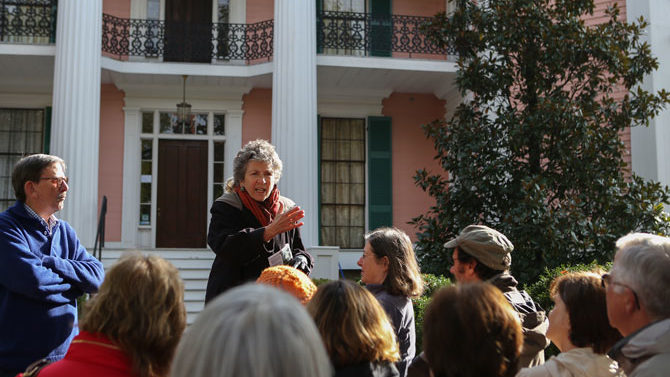What do changing street names, a brothel and the other Piedmont Park all have in common? All three are what former mayor Gwen O’Looney would call “little treasures” of Cobbham, Athens’ first historic district, founded in 1978.
On the Athens-Clarke Heritage Foundation’s final historic walking tour of the year, O’Looney led a group through the winding streets of Cobbham, an area located roughly between Prince Avenue and Hancock Avenue from downtown to Athens Regional. The neighborhood is the namesake of an English settlement, and is controversially known as Athens’ first suburb because of its origin as an 80-lot speculative development laid out by Col. John Addison Cobb in 1834. Later, 80 lots became 120 as demand for the “Snob-ham” area grew.
The neighborhood boasts several notable past residents, including T.R.R. Cobb, the lawyer and Confederate officer best known for his role in drafting what became the first successful codification of common law in the U.S. (“Everyone in Athens that’s been around here long enough is related to a Cobb,” O’Looney said.) Others include Ben Epps, Georgia’s first aviator; Lucy Stanton, the painter of portrait miniatures; and Edward Larson, a historian who won the Pulitzer Prize for his book Summer for the Gods: The Scopes Trial and America’s Continuing Debate Over Science and Religion.
Athens even has its own Piedmont Park, located at the corner of Church and Hill streets. The lot was once the location of two historic homes, demolished after Prince Avenue Baptist Church bought the properties to build a parking lot. Collaboration between Piedmont College—which has bought, restored and maintained several historic Cobbham houses—and the Historic Cobbham Foundation returned open green space to the neighborhood.
The seemingly endless tales of Cobbham kept the bundled-up group on their toes for nearly three hours. The big names and the even bigger houses are impressive, to say the least, but it was O’Looney’s quick-witted humor and self-professed love of gossip (“Gossip is people, and I think people are interesting”) that rendered the group hooked.
And hooked they were when O’Looney pointed out what she called a “community service house,” or in other words, a brothel. In that orange-painted house on Hill Street, “it cost more to love the mistress than it did the other ladies,” she said, “because the mistress’ room was underneath the pyramid,” a room with a vaulted, pyramid-shaped ceiling said to “enhance the activities therein.”
Across the street stands a house that has served several different purposes, including a fraternity house, boarding house and a bed-and-breakfast called Magnolia Terrace. One of the tour attendees, James Lineberger, a longtime Athens resident, said working at the boarding house during the 1980s and receiving free meals was what put him through graduate school.
Further along, the group passed the Cobb-Bucknell-Leathers House, where the Confederate constitution was read from the balcony in 1861. The history of Cobbham as being home to many wealthy Athenians, many of whom served in various roles of the Confederacy, has also lent itself to strange, yet perhaps fitting, designs. In Cobbham, couriers have discovered the perplexing name-changing of Chase Street to Prince Place for one block, then back to Chase Street. The reasoning was that Cobbham residents didn’t want others to know they were near Chase Street, at that time a predominantly African-American area. “Oh, how little are our minds,” O’Looney remarked.
O’Looney and her husband are not only protectors of the cherished district, but proud residents. A tour pit-stop included a peek inside the O’Looneys’ purple-hued home, decorated floor-to-ceiling with antiques, local art and John O’Looney’s boldly painted portraits. Their lot is typical of Cobbham, a large home on a large lot with several outbuildings behind it. Some of those buildings once served as kitchens, during the era when many feared their houses would catch fire. Many Cobbham residents have converted their outbuildings to studios, garages, guest houses or even small cottages that they rent out, but whatever their use, they are “like little jewels,” Gwen O’Looney said. Like many of their neighbors, the O’Looneys took years to renovate the house, restoring it to its turn-of-the-20th-Century glory, and amplifying its “community aspect” by adding a porch.
Others have faced even more extensive renovation, including the T.R.R. Cobb house, which has been moved from its original site to Stone Mountain and back to Cobbham. While the T.R.R. Cobb House is certainly the most well-known of the area, O’Looney has been just as determined to save smaller, lesser-known properties. “We don’t just want the biggies, we want the littlies, too,” she said.
Since the historic district was created in 1978, Cobbham, like other Athens neighborhoods, has seen many renters, college students and musicians come and go. Several of the most well-done renovations, O’Looney pointed out, are currently rental properties, and are carefully maintained. With the help of passionate philanthropists and historic-preservation enthusiasts, the district has survived and even thrived. History professor and preservation activist Phinizy Spalding and members of R.E.M. have lived in, renovated and made contributions to Cobbham’s homes. Now, by renting out the old jail, the Historic Cobbham Foundation earns money to dedicate towards continued renovations, planting trees and future projects like art installments in its parks.
The lengthier histories of Cobbham and its individual properties can be read in the Historic Cobbham Foundation’s printable brochure on the Cobbham district, or you walk at your own pace following the new Google Maps tour of Cobbham.
Like what you just read? Support Flagpole by making a donation today. Every dollar you give helps fund our ongoing mission to provide Athens with quality, independent journalism.










